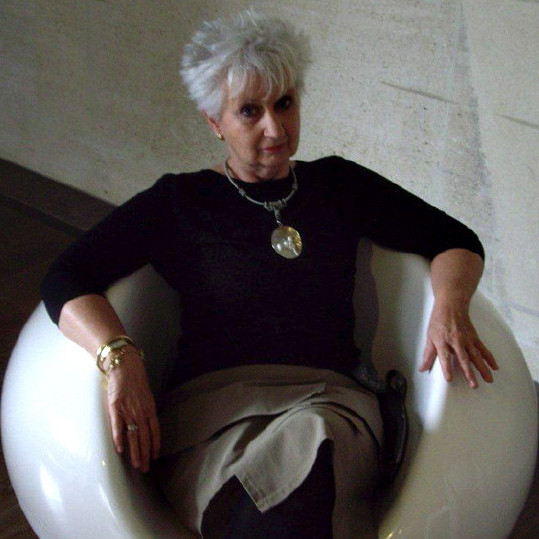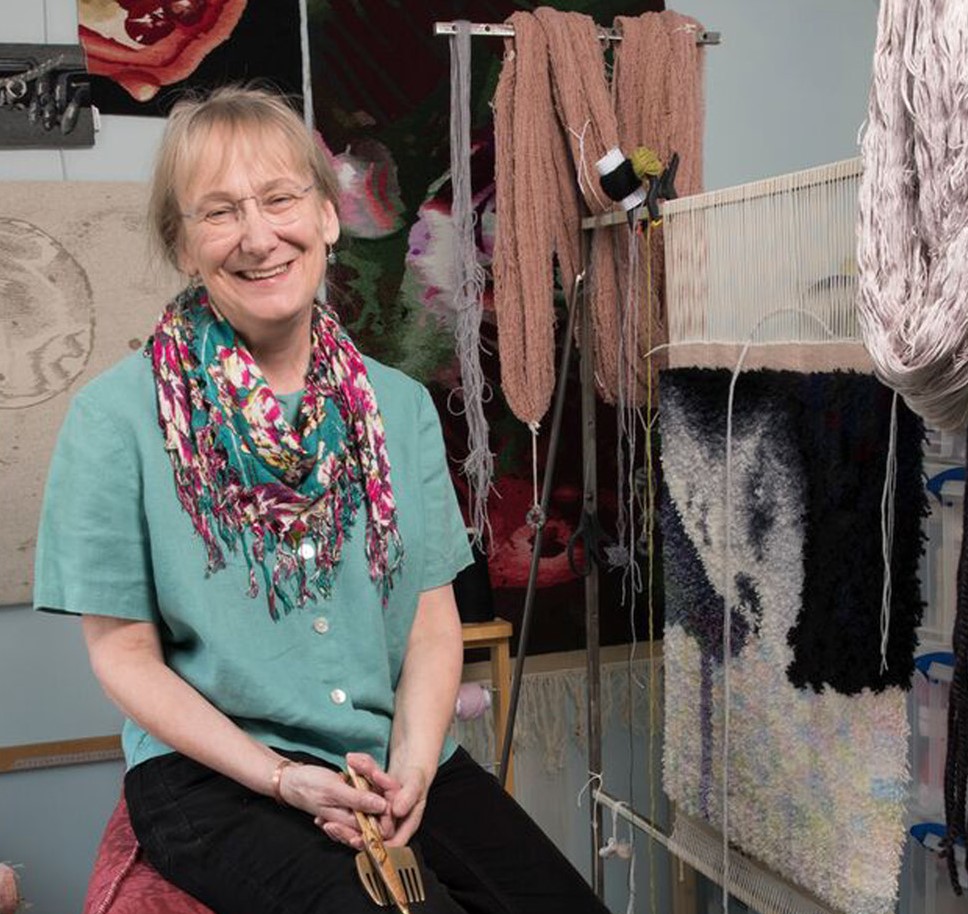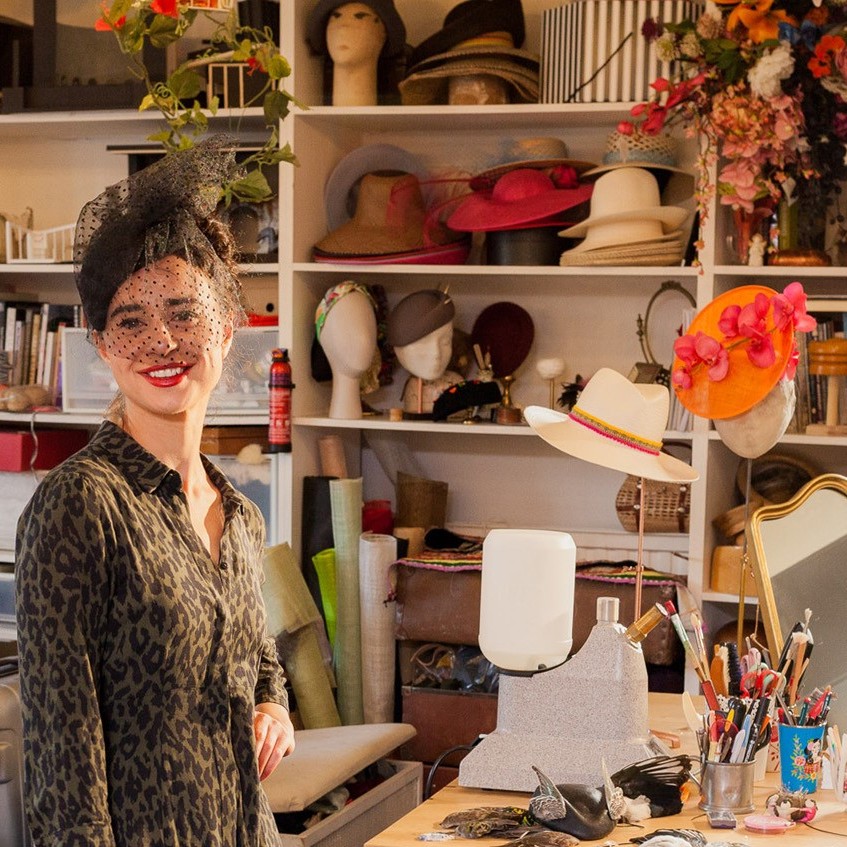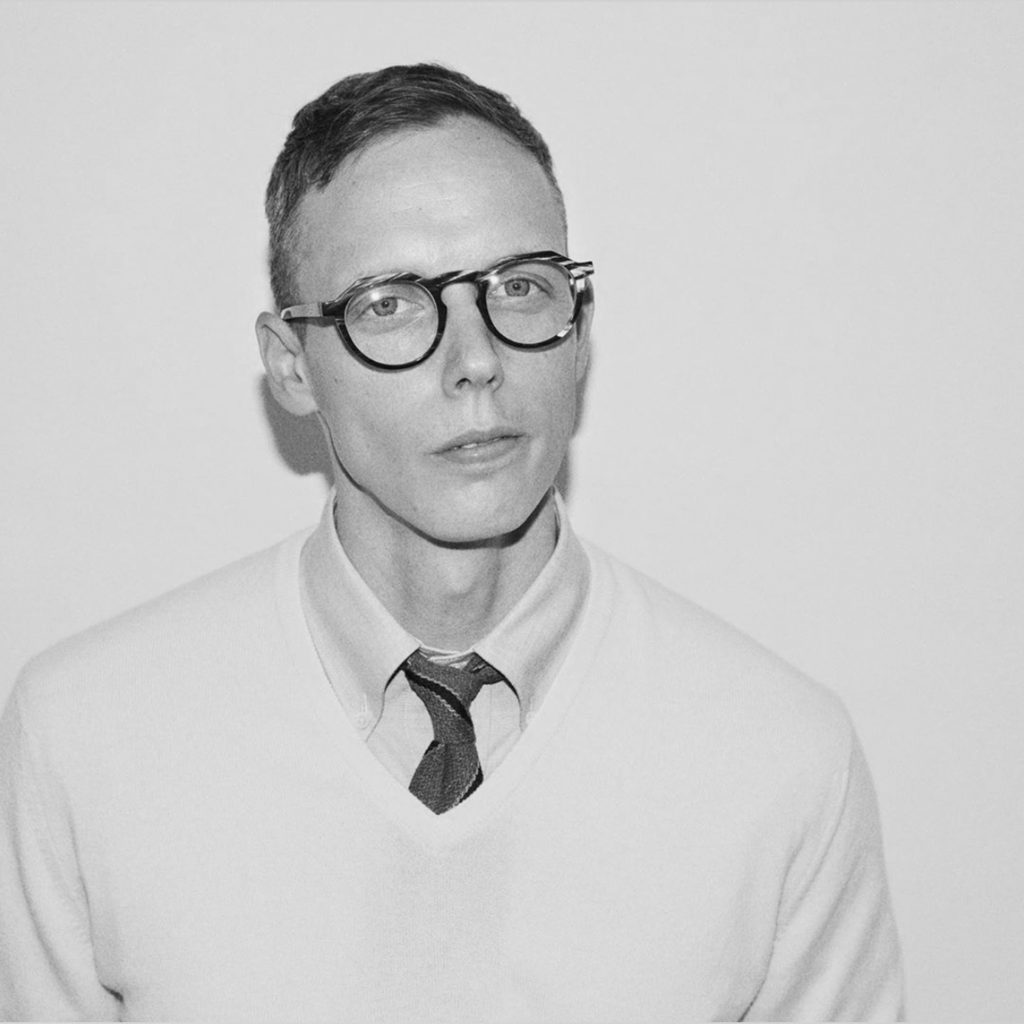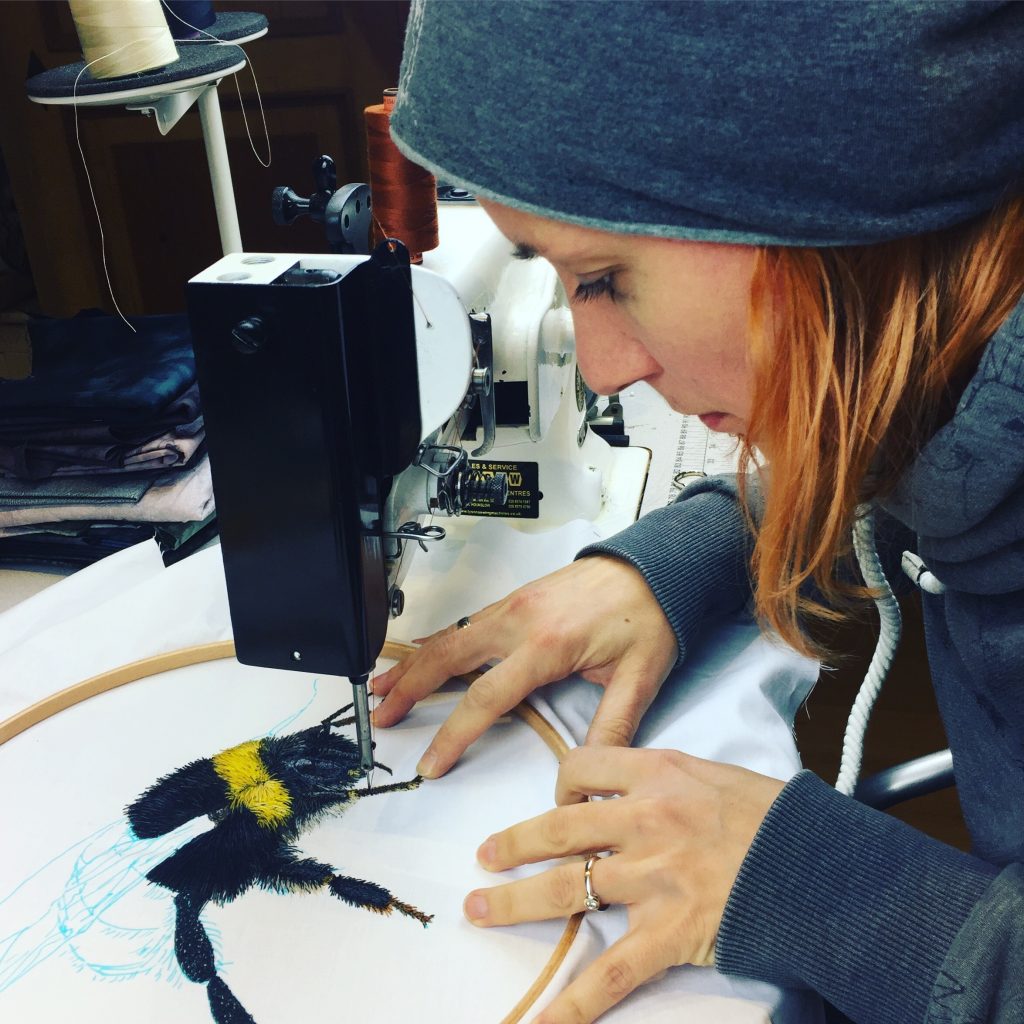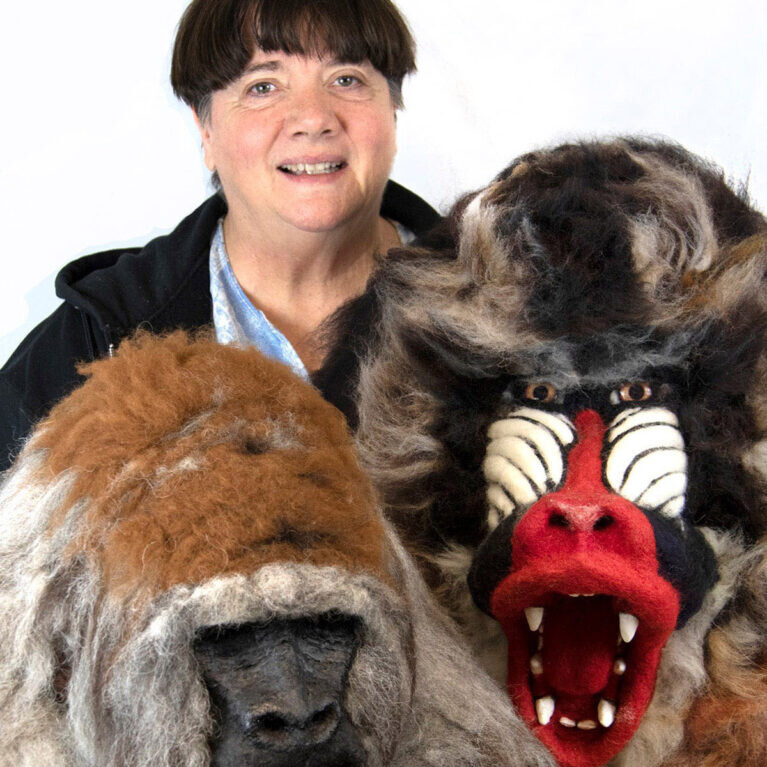Margaret Jones Tapestry Weaver
Can you explain ‘The Way of All Flesh’?
This piece came out of seeing the scans of my Mums brain when she was diagnosed with vascular dementia. It is not a replica of the scan by any means but the image grew in my mind and after much thought resolved into this piece.
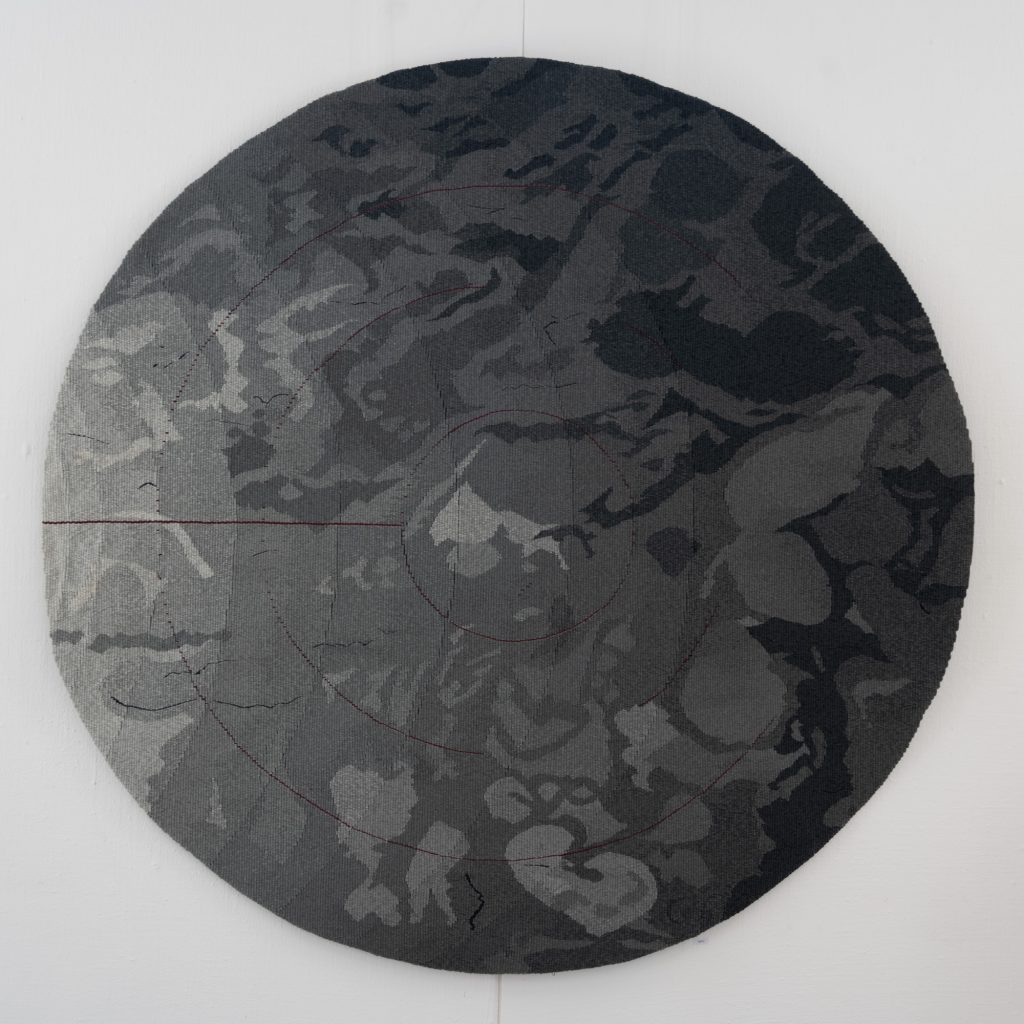
The Way of all Flesh, 147cm diameter
The red circles are fragmented and the image is disordered just as her memory was. I always saw the piece in this grey green colour right from the start, not because our brains are ‘grey matter’ but because that was how I saw her life. Many dementia groups encourage you to see the joy in dementia but regrettably there was no joy in my Mum’s life once the disease became apparent.
I had thought of weaving another piece of the same size in the same colours but a more ordered image indicating a healthy mind. I may still do this.
The tapestry is 147cm in diameter with a limited palette of 5 shades of a grey green colour and red and black linen.
My circular tapestries are not woven round and round in a circle, they are woven from left to right as normal, so the first pass at the bottom of the tapestry is quite short, as is the last one at the top. I usually have a piece of card inserted into the warps which is the negative shape of the bottom of the circle, this gives a solid base to weave onto. If you do not have a solid foundation then you will struggle to get a good consistent weave throughout a tapestry no matter what the shape.
People often admire my round tapestries and ask how I manage to get them so round but to be honest I am helped out hugely by the human eye and brain, people see that they should be perfectly round so they see them as perfectly round.
Can you discuss your current thoughts on making small: therefore, pieces with a smaller commercial value?
It is so difficult. Tapestries are traditionally big murals that run, in series and tell stories. It is not until you walk into a gallery hung with large tapestries that you realise so much of it is all about scale.
However, in the 21st century this brings problems, who has the money to buy these big mural tapestries? Who has the walls big enough to exhibit them? Even some of the larger tapestry exhibitions have size limits on each work, so my current triptych of three tapestries with a total width of 4.5 metres has nowhere to go.
As artists many of the galleries we exhibit in are smaller provincial galleries, they do not often get visited by people willing to spend thousands of pounds on a tapestry so it makes sense to produce smaller work.
But for me personally this is tricky. I cannot just take the designs for the large work and make it smaller. I usually weave at around 3 or 4 warps to the centimetre but if I was to make the work smaller and still want to get in the details I would have to weave at 14 or 16 warps to the centimetre, which becomes cloth rather than tapestry.
This means I have to do special designs for smaller work but I find apart from the occasional portrait I am not happy with these smaller works. It is a conundrum I struggle with.
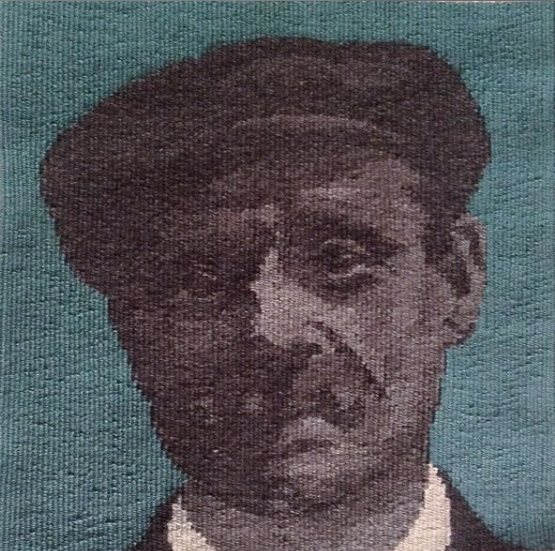
Great Uncle Antonio, 30cm x 30cm
How has the pandemic effected sales and the general effect from an English artist’s point of view?
Because tapestry is a slow medium, I have not felt that it has had much impact on me at all. When we went into lockdown I was about two thirds of the way through a big tapestry so I just kept weaving. I then went straight into my next project which is 2.5 metres wide which I am still weaving. As a rule, I spend many days isolated in my studio so not much has changed. I know some weavers lost their creativity and direction due to the Covid crisis, but I am fortunate not to be one of them. If I hadn’t had work in the pipeline. I may have struggled but I whilst I am weaving a piece there are generally two or three projects in my head ready to go.
Discuss the importance of entering your work in International exhibitions.
International exhibitions are important to get your work out there and be seen as much as possible. No-one will have heard of you if you never exhibit your work. I have been fortunate enough to have work included in publications, been invited to exhibit and to speak at conferences specifically because my work was seen overseas.
The UK has suffered from not having much in the way of the big tapestry exhibitions, so we have, to go abroad. The British Tapestry Group have done some in the past but none recently and The Cordis in Scotland takes larger works. Again, it is a problem for weavers who want to weave traditionally sized tapestries. I started the Heallreaf exhibitions in 2015 and we now take work up to 2 metres square, it is difficult to find venues big enough and even 2 metres square is not big when you look at historical tapestries. Another consideration is that it costs a lot of money to send your work abroad. In 2019 I was invited to exhibit in Canada and it was almost cheaper to fly to Canada and take the tapestry in person than send it by courier.
Is it difficult to keep to your own artistic direction rather that producing work that is easy to sell or what a gallery wants?
I have only ever once made a piece of work specifically because I thought it would sell and fit in with the current ‘interior design’ trends. It was small and sold instantly but it is not work I particularly want to keep making, so I have not. I also struggle with exhibitions that have a theme, I find I have to take time out from the work I am currently producing to find a link to the theme that I can work with and then produce the tapestry. I do understand that often a theme can give an exhibition cohesion and it can be a useful tool to stretch your creative mind but sometimes it is hard to work within other peoples, constraints and maintain the integrity of your own practice.
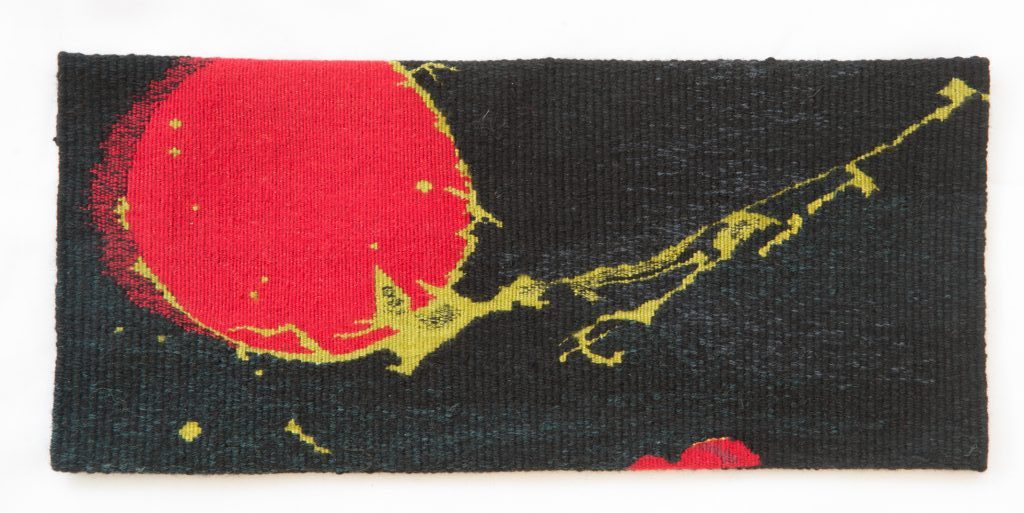
Red Shift Two, 30cm x 20cm
Do you do your own dyeing?
I don’t have a dedicated dye room so I will often buy colours but it can be difficult to find the right colour; I have spent the last month dyeing greens for my next project because I cannot source the right green from anywhere in the UK. Sometimes the results of my dyeing can be less than perfect so if I need yarn that is dyed very well with a good solid colour (for instance if I am going to weave a large area of one dark colour) I can get yarn dyed for me specially, although there is often a long lead time so I have to know many months in advance exactly what I want.
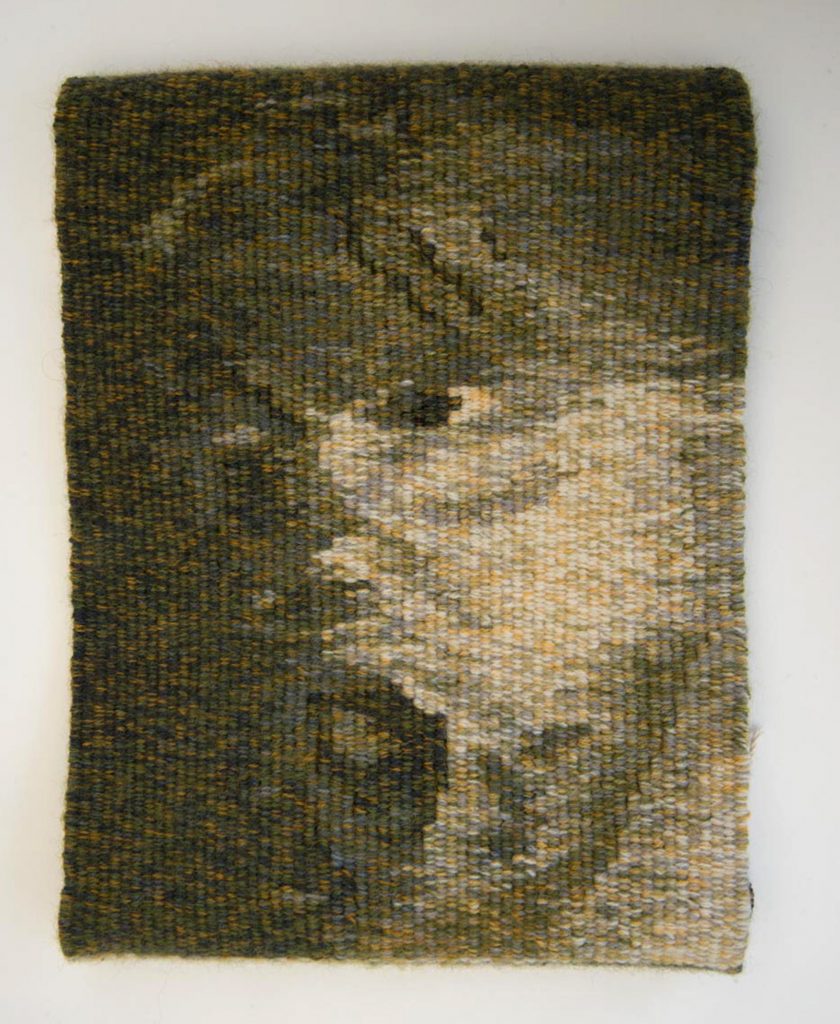
Green Man, 30cm x 20cm
Are your dyes natural or organic and why the choices?
I use acid dyes. This is because they give consistent and repeatable results, and they are very colour fast. Environmentally they appear to be no worse than many natural dyes as the mordants you need to use for natural dyes are not necessarily good for the environment. The dye company tells me that if you exhaust the dye bath, that is: use just the right amount of dye so it all goes into the yarn and none is left in the water, all you have left is water and you could drink it without any harmful effects. I am not brave enough to try it, but it does appear to be just water.
I have recently been experimenting with dyeing with pigments with varied success, that is a long-term project for the future.
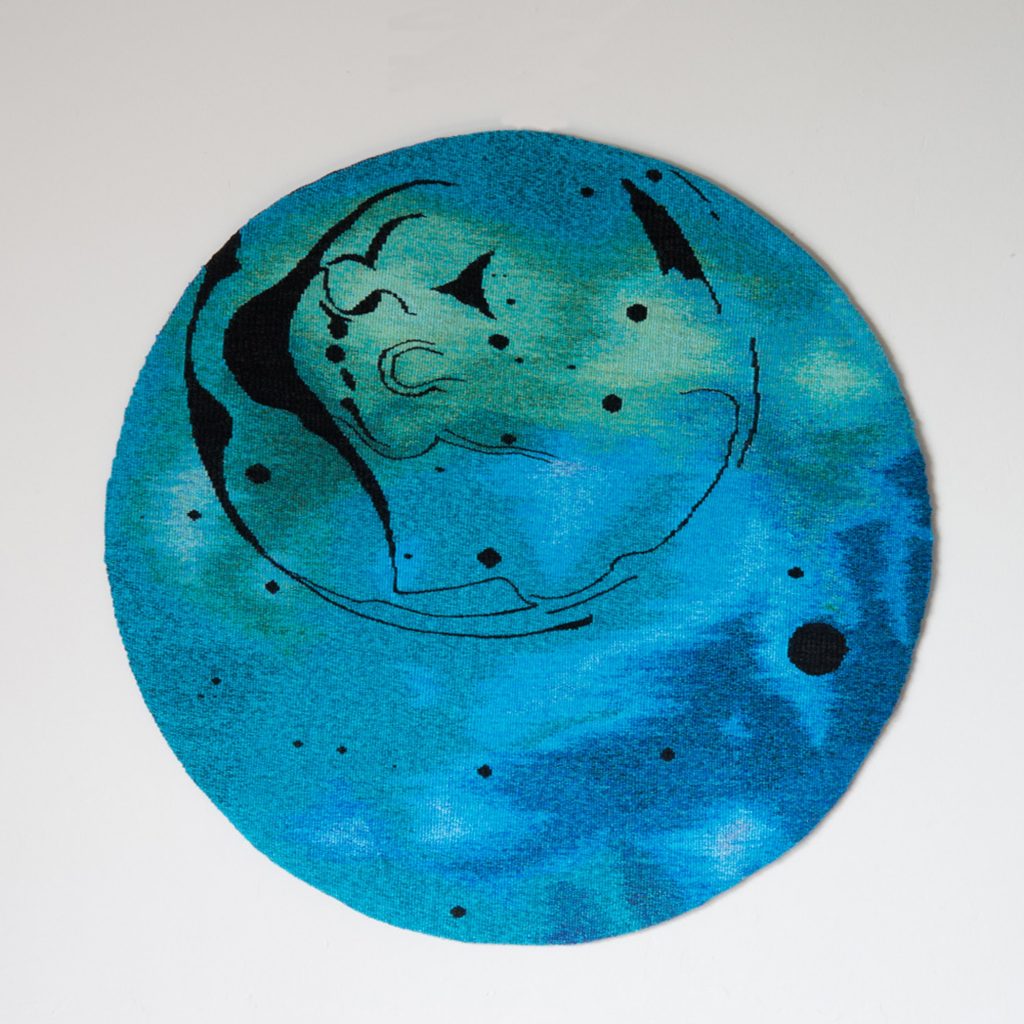
Blue, 75cm diameter
Do you use merino wool or other breeds?
Merino wool is generally too soft for tapestry weaving. I use a worsted yarn which is more traditional in the UK, it is a harder yarn with little or no loft and I try to find a mix of fleeces from sheep like a Corriedale or Leicester. Blue faced Leicester is particularly good but expensive and difficult to get hold of in quantity in the right thicknesses.
Strangely it can be difficult to get worsted yarn in the UK. This is because of an historical decision to breed sheep for meat in the UK and for fleece in the Antipodies.
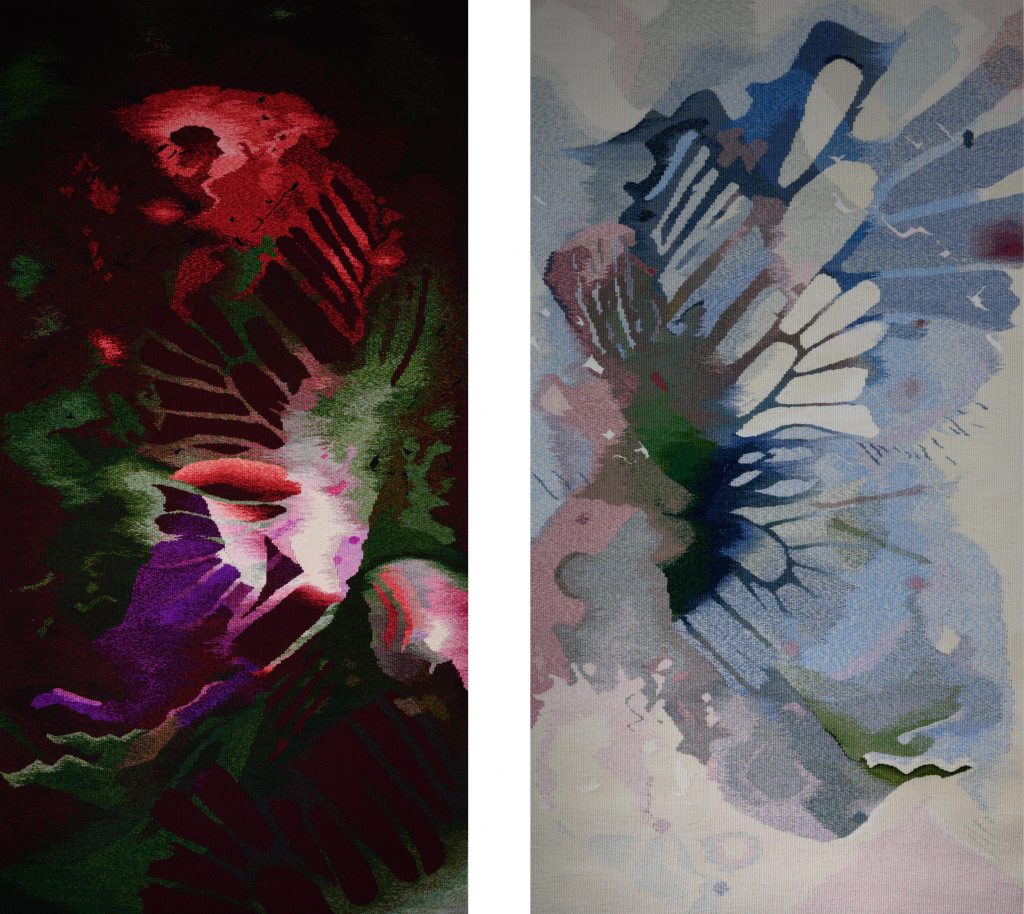
The Fallen Diptych, 150cm x 150cm
Can you explain what these terms are?
Cutting off
Cutting off is just what it says. When you have finished a tapestry you tie a row of knots across the top to keep the weaving in place and then you take your scissors and cut the warp threads below and above the weaving, liberating the tapestry from the frame or loom.
Blocking out
Sometimes after you have cut the tapestry off it can look a bit lumpy, especially if your tension was not as consistent as it could be so you can block it out. This involves placing it face down on a board and pinning it round the edges with brass nails every centimetre or so. Then, once you have done this you place damp cloths on top of the tapestry and leave them to dry. This tightens up the weft and can remove any bagginess in the tapestry. Even if the tapestry does not need blocking to correct any anomalies within the tension it does wonders for the look of the tapestry, the slightly tightened weft gives a lovely smart finish which is difficult to describe.
Discuss a commission you have both done and enjoyed.
This commission came about when the client liked a piece of my work that was already sold. Fortunately, the client allowed me pretty free reign as I undertook to create something like but not the same as they piece they originally chose. Totally independently I had just finished a piece of work for an exhibition in Istanbul but that work had to be completely tufted, like a rug and I had fallen in love with the technique.
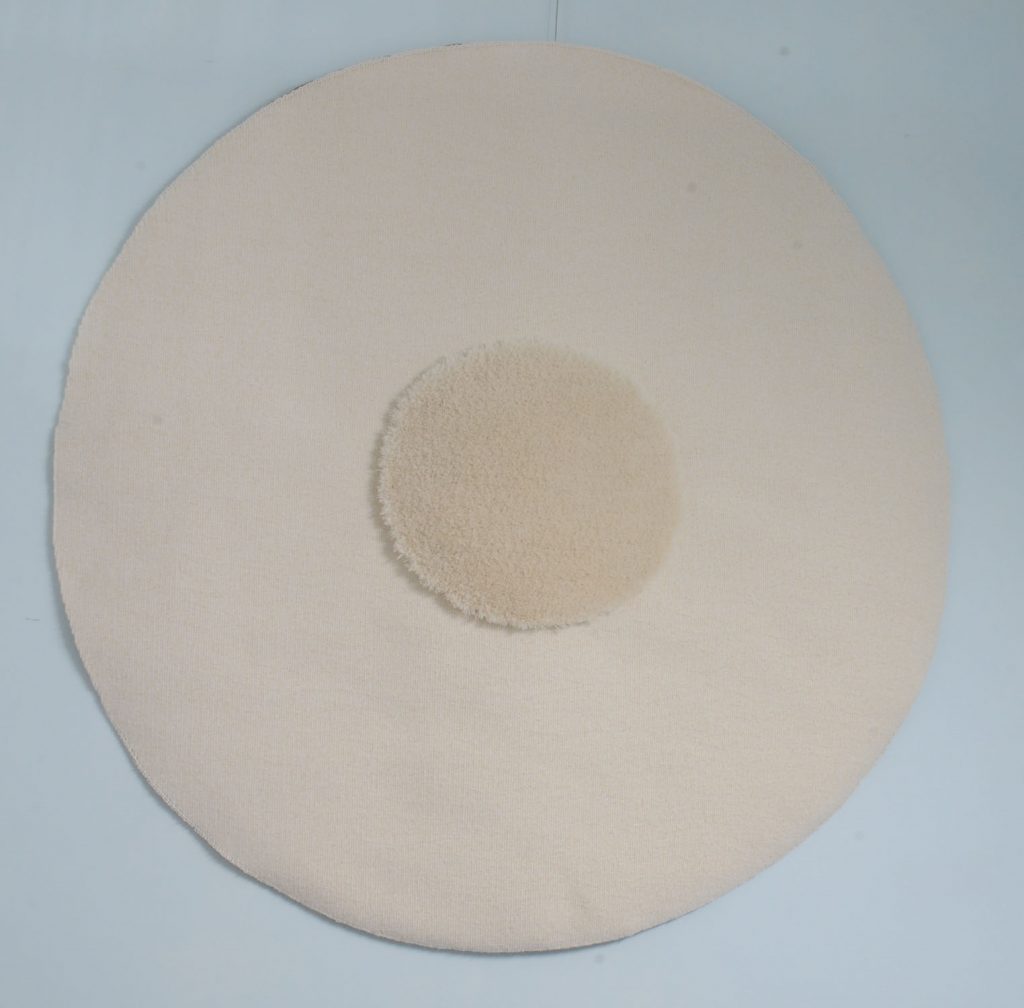
Commission – 100cm diameter.
So the commission became a round tapestry with a disk of tufting in the centre. This idea of the 3D and the circular nature of the tapestry echoed the original piece the client had admired. I enjoyed it but quickly realised that the commission was woven much more finely that the ‘rug’ piece I had woven for Istanbul, consequently the small tufted area in the middle took as long to weave as the whole of the rest of the tapestry. I sort of fell out of love with tufting after that but that doesn’t mean I will never do it again if a tapestry needs that sort of effect.
Where did you learn to weave?
I wove, my first pass of tapestry on 10th December 2010. I became immediately obsessed with it as I found I intuitively understood many of the techniques and how to blend and use yarn to make the images I wanted. It was on a short course at West Dean College and I quickly went onto to do more short courses and in 2012 enrolled on the three year full time course to do my MFA specialising in tapestry weaving. I continue to do the odd course even now as it is rare that you don’t learn something new from other weavers, we all learnt and work in very different ways.
What did it mean to be awarded the Qest Scholarship?
In order to become a Qest scholar you have to prove to a panel that you are committed and passionate about your chosen craft, it is a wonderful honour and achievement. Qest follow your career and once a Qest Scholar always a Qest Scholar so the organisation does not give you, your scholarship and then forget about you. Scholars meet regularly (until Covid that is) for social events and exhibitions and I was fortunate to be included in their book ‘A Celebration of British Craftmanship’.

My links with Qest will continue with exhibitions, sales of work and receiving the support they can offer at various events and likewise supporting them in any way I can. I have donated work to their auctions which help raise large amounts of money for the charity.
Expand on your “Pods”.
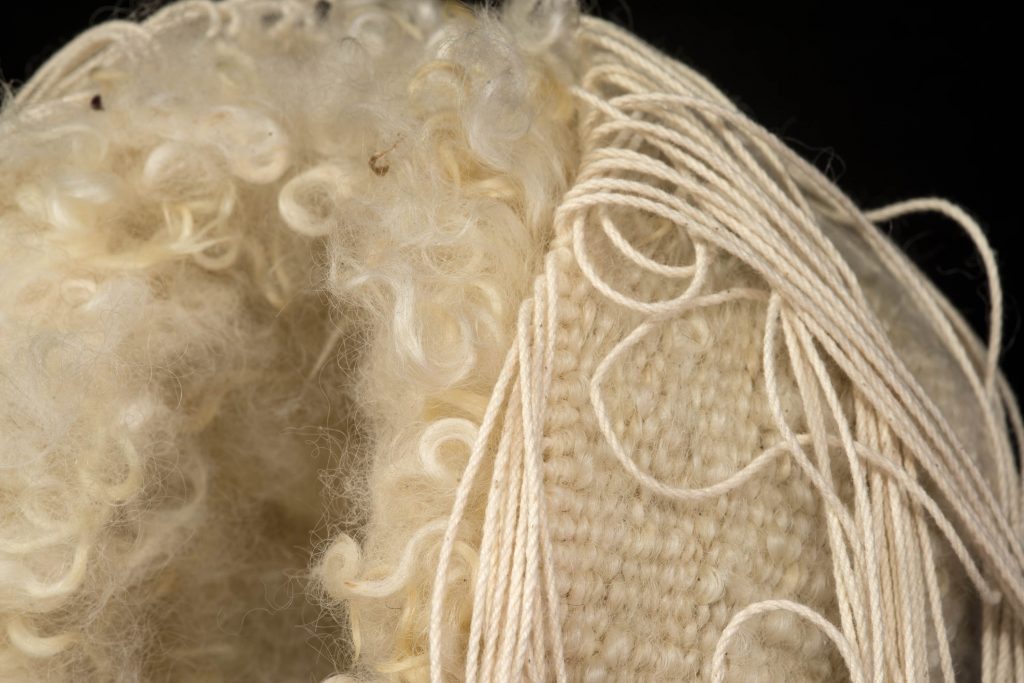
Pod cast detail
The pods were an experiment for the second year of my MFA when I was at college. It started because I had seen the amazing tapestry heads created by Louise Bourgeois but I was so disappointed when I realised that they were tiny pieces of tapestry sewn together to make the face shape, presumably they are sewn around a mannequins face. So I set out to make 3D shapes in tapestry but with as little sewing as possible and that was how my pods started. Since then I have experimented with different materials and different sizes and using the same basic techniques I have made corsets and other experimental work. However, the pods themselves are a little disappointing in my view, okay it is a pod or sphere of handwoven tapestry, brilliant but what next? This is the question that has sat with me for 4 or 5 years until now, I have just started working on large scale woven 3D shapes, using the same pod technique but making life size anthropomorphic structures.
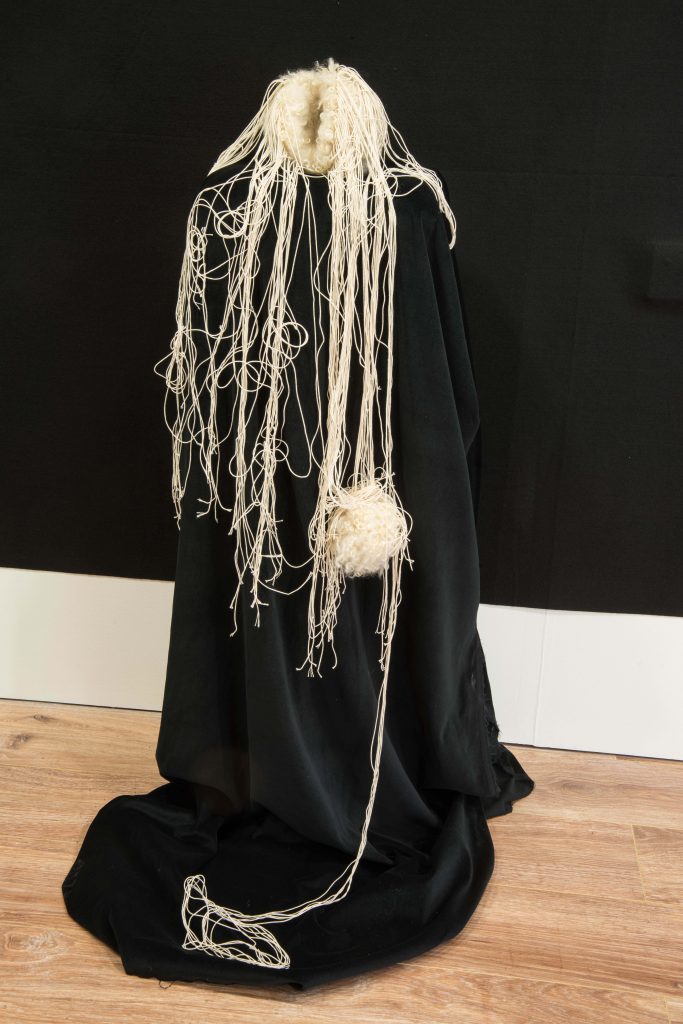
Pod Cast
Take two tapestries that are quite different and expand briefly on each work.
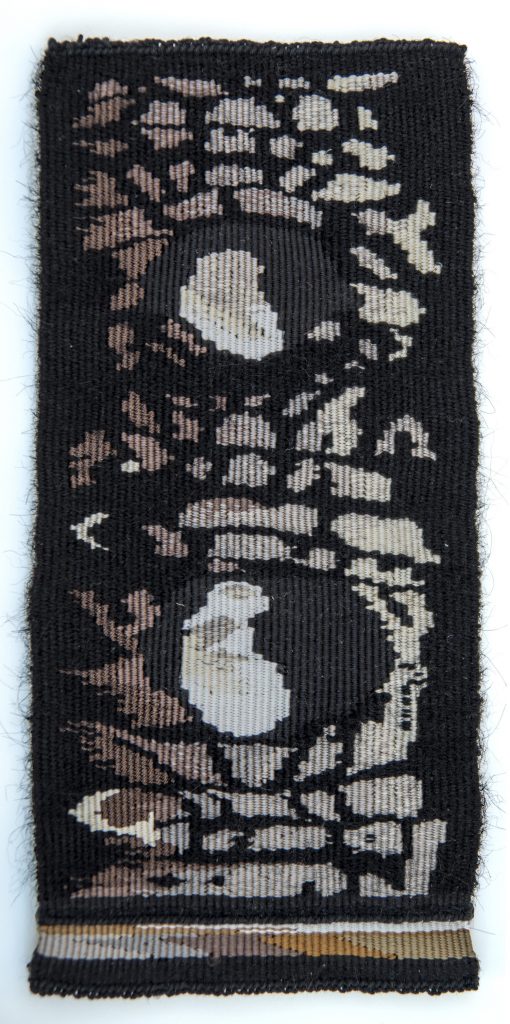
Hawk Moth Caterpillar – 25 x 11.5cm
This small tapestry came about after I found a hawk moth caterpillar in the garden. They are quite amazing little creatures and I was fascinated by the colours, shape and texture of it’s skin. This was one of my very early tapestries and the design is almost a direct copy of the markings on the caterpillar but I wanted to convey the texture so used wool for the black background and silk for the coloured markings. It was the first time I had used silk and I found the silk areas are very ‘boney’, that is, the line of the warp threads is much more visible than in the wool areas. This worked well as it accentuated the 3D effect of the markings.
This tapestry was the first I ever had accepted into an overseas exhibition as it was shortlisted for the Kate Derum Award in 2013 Australia. It is now in private collection in the UK.
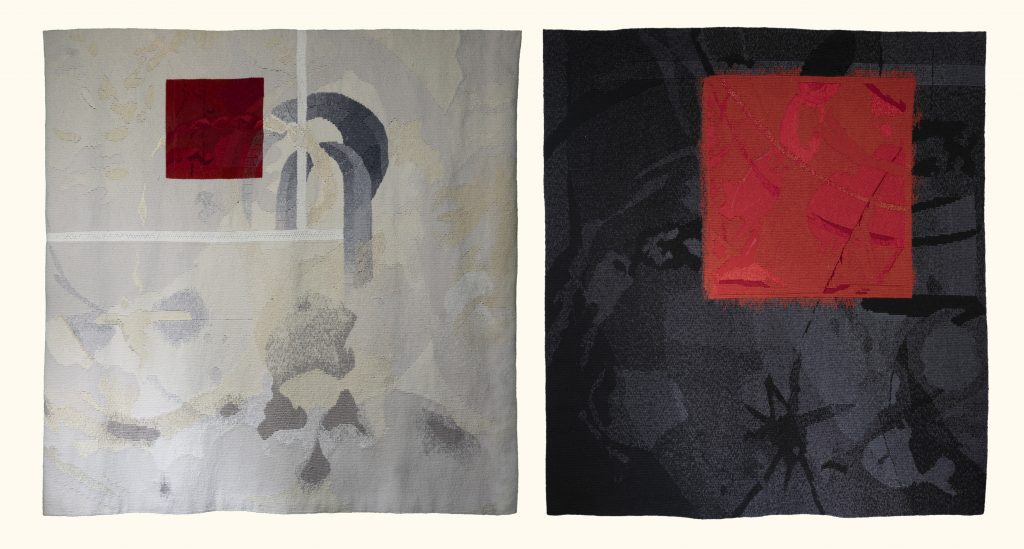
Cecil – The Uninvited Guest – 1.5 x 3m
2019 was a tough year, my husband was very ill and for 3 months the doctors thought he had potentially terminal cancer. The good news was that he did no, but he was still very unwell and in and out of hospital all year.
These tapestries were a response to the year, combining my husbands image, some of his CT scans and other elements that occurred to me during the design process. I do not do a lot of drawing nor do I keep a sketch book, designs turn up in my head fully formed and ready to go in full colour, they are then translated to paper using photographs, drawing and collage. I have a lot of time to think about the designs whilst weaving and in the past I have tried to move the designs on from this mental image but always come back to pretty much the original because it is fresh and the later amendments to a design tend to make it look over worked and forced.
I used wool warp for these tapestries and I don’t think I will do that again, I will go back to cotton warp. Part of the reason for doing it was because I had never used wool warp on a large piece before and I thought it would make the finished tapestry lighter but on both of these pieces the tapestry fought me all the way.
I am considering doing a third in the series in red but need a rest from them for a bit. I have started writing poetry to go with some of my works and ‘Cecil – The Uninvited Guest’ has been distinguished with a poem.
Cecil – The Uninvited Guest
You arrived out of the blue
initially insidious
potentially terminal
uninvited
unwelcome
you stayed a year
you flaunted yourself
you burrowed
like a twisted broken skein
drawn taut inside
you oozed
you flowed
you fought
but eventually
you failed
leaving scars
and a
memory
good riddance
we say
the
doors
are closed
do not return
These tapestries are currently in my studio waiting for an opportunity to be exhibited.
Contact:
Margaret Jones
www.margaretjonesartistweaver.com
Instagram: margaretjones6979
Interview by Deborah Blakeley, October 2020
Blakeley, Melbourne, Australia
Think a colleague or friend could benefit from this interview?
Knowledge is one of the biggest assets in any business. So why not forward this on to your friends and colleagues so they too can start taking advantage of the insightful information the artist has given?
Other artists you may be interested in:

